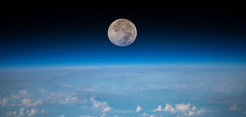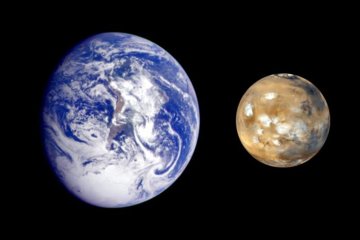"The Moon is one of the most important archives"
Urs Mall from the Max Planck Institute for Solar System Research on exploring the Earth’s satellite 50 years after the Apollo missions
Twelve people have landed on the Moon, exploring its surface. However, there was just one scientist among the astronauts – the geologist Harrison Schmitt. He visited the Earth’s satellite in December 1972, on board the Apollo 17, the last mission of the programme. After that, public interest in the Moon declined. However, this marked just the beginning for research. What do we know now about the celestial body closest to Earth? Has it been possible to discover new facts? Are there any questions that remain unanswered? We spoke to Urs Mall, a scientist at the Max Planck Institute for Solar System Research in Göttingen.

Mr Mall, the Apollo missions brought around 384 kilogrammes of moon rock back to Earth overall. What have we learned from it?
For the first time, thanks to Apollo, humans were able to access extraterrestrial material that they themselves had fetched from another terrestrial body. In this way, it became clear that the Moon is not an original object, and that it has an inner structure. The laboratory analysis of the lunar material that has been brought back has made it possible to determine the mineralogical and chemical composition of these rocks. It has emerged that this material is related to our Earth. It has now also been possible to date the rock, and to investigate when a particular rock was created. Naturally, the age of these samples varies widely, although the oldest is at least 4.42 billion years old. This rock therefore originates from the early phase of the Moon. All these studies put an end to speculation as to whether there might be living organisms on the Moon.
You mention the early phase of the Moon. When was the Moon actually born?

A highly probable theory states that primordial Earth collided with a protoplanet that was approximately the size of Mars, which is referred to by scientists as Theia. This collision, was not frontal; instead, the two planets grazed each other. As a result of this cosmic collision, large quantities of material were catapulted into the Earth’s orbit, from which the Moon was formed over a period of several thousand to hundreds of thousands of years. This primitive Moon must have initially been covered with a thick layer of liquid molten material known as the magma ocean. Here, an exciting debate is being conducted as to how and over what length of time this magma ocean cooled down. We also want to find out something about the mechanisms that caused this molten material to become solid. All this has implications for our understanding of the history of our own Earth. However, when it comes to the subject of the creation of the Moon, a series of theories have begun to be circulated in recent years that somewhat modify the collision theory.
Today, billions of years later, the Moon and Earth look entirely different...
... yes, since a great deal of change is occurring on Earth with its atmosphere, with continuous destruction and renewal of the surface. The main reason for this is tectonics, when the plates of the lithosphere collide, reform or disappear into the depths of the Earth during the course of the Earth’s history. This doesn't exist in this form on the Moon. Since there is no renewal process, the initial state remains intact as though frozen. In this way, this celestial body still shows traces of the bombardment with bodies from the beginnings of the solar system, in other words, numerous craters. By measuring these, we can draw conclusions about their origins. The development of the Sun can also be reconstructed, since the solar wind, a flow of charged particles, has become deposited on the surface of the Moon over billions of years. In short: the Moon is probably the most important archive of the history of our solar system.
A central issue with regard to the birth and development of the solar system relates to the role played by water. What is the situation with the Moon?
Initially, no water was found in the Apollo rocks. What the teams did find was ascribed to contamination from Earth. However, the samples are still being examined today, and of course with better and more sensitive instruments than those available several decades ago. In 2008, for example, evidence was in fact found of traces of water in a sample during renewed analysis. In the interim, water has been found in many samples. To put it more precisely: what is measured in the minerals are chemically bonded hydrates and hydroxides.
Where does this water come from?
That’s precisely the big question! In principle, there are two possibilities: either it was already there when the Moon was formed, in which case it came from an endogenous source, or the water was later transported during the bombardment, for example by comets or asteroids. This would mean that it came from an exogenous source. We still don’t have a clear answer to this question.
When there is water in moon rock, must it not also be possible to prove this remotely?
Yes, the first successful attempt to do so was made by the Indian space probe Chandrayaan-1 in 2008, using an infrared spectrometer. Naturally, a few experiments had already been conducted previously. But let me make one thing clear: there is no water on the Moon like the water on Earth. In other words, it is not present in its molecular form, as H2O. On the one hand, water would immediately evaporate due to the lack of atmosphere, and on the other hand, the sunlight would destroy the molecules, whereby the light hydrogen would escape into the atmosphere due to the lack of gravity. What we are finding is probably hydroxyl with the chemical formula OH-. Incidentally, particularly large deposits are expected to be found on the poles of the Moon; there, it would indeed also be possible to find ice.
Why there, and not elsewhere?
The hydroxyl molecule I mentioned just now, or individual H2O molecules, act like balls that hit the surface. After the first impact, they don’t stand still, but jump about. Some of these molecules then reach the polar regions at some point according to the random principle. There, there are craters that are permanently in shadow, and which are therefore extremely cold. Then, the same thing happens as when you put your finger into a deep freezer - they get stuck. The same thing happens to the molecules, which then collect at the coldest locations.
You mentioned an unmanned space probe, which was launched in 2008. Last January, the Chinese landed on the far side of the Moon. Are further missions being planned?
In July, the Indian probe Chandrayaan-2 is due to be launched, which will continue the work of its predecessor. Unfortunately, the Germans are not involved, although after Chandrayaan-1, we were offered the chance of taking part in this mission. However, evidently, the sponsors in this country are not particularly interested in lunar research. It is only thanks to the German Aerospace Center (the DLR) manned space travel division, the ISS and Exploration, and the initiative of the former Max Planck President Peter Gruss that we have been able to participate in missions to the Moon in the past. The German Aerospace Center isn’t planning any projects of this type either. The Americans and Russians are all the more active in this field. From 2021 to 2026, the Luna 25 to Luna 29 probes are due to fly to the Moon as part of the Russian Luna-Glob programme. Unfortunately, we don’t have the funds to build the hardware for them. But we are at least involved as co-experimenters. And then, we should of course not forget our successful Chinese colleagues, who with their Chang’e programme made a spectacular début in the field of lunar research, which they will drive forward very decisively over the coming years.
Should people fly to the Moon again?
The Americans have set themselves the goal of sending the first female astronaut to the Moon in 2024 as part of the Artemis programme and starting a whole sequence of landings in pursuit of both scientific and commercial interests. To give a specific answer to your question: in my view, there’s already a lot that can be done today with robotics. On the other hand, it is of course better to have people on site, since they can make active interventions and react appropriately in certain situations. Ultimately, it’s a matter of money.
The interview was conducted by Helmut Hornung













